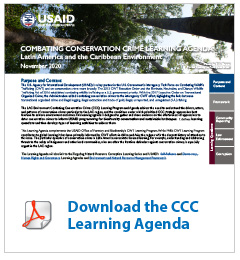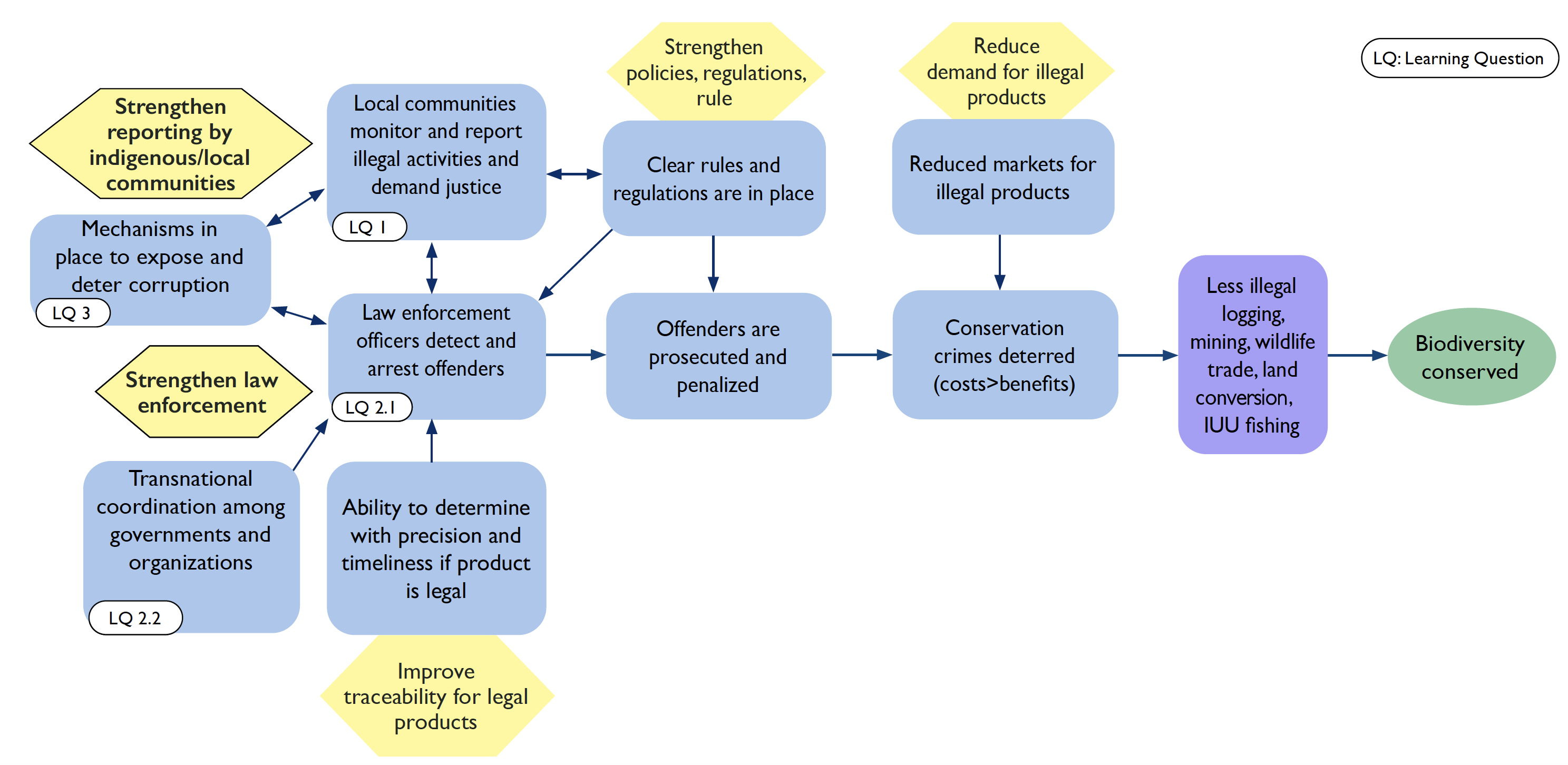Learning Agenda
Purpose and Context
 The U.S. Agency for International Development (USAID) is a key partner in the U.S. Government’s interagency Task Force on Combating Wildlife Trafficking (CWT) and on conservation crime more broadly. The 2013 CWT Executive Order and the Eliminate, Neutralize, and Disrupt Wildlife Trafficking Act of 2016 established combating wildlife trafficking as a U.S. government priority. With the 2017 Executive Order on Transnational Organized Crime, the Administration added combating conservation crimes to the interagency CWT effort, highlighting the links between transnational organized crime and illegal logging, illegal extraction and trade of gold, illegal, unreported, and unregulated (IUU) fishing.
The U.S. Agency for International Development (USAID) is a key partner in the U.S. Government’s interagency Task Force on Combating Wildlife Trafficking (CWT) and on conservation crime more broadly. The 2013 CWT Executive Order and the Eliminate, Neutralize, and Disrupt Wildlife Trafficking Act of 2016 established combating wildlife trafficking as a U.S. government priority. With the 2017 Executive Order on Transnational Organized Crime, the Administration added combating conservation crimes to the interagency CWT effort, highlighting the links between transnational organized crime and illegal logging, illegal extraction and trade of gold, illegal, unreported, and unregulated (IUU) fishing.
The LAC Environment Combating Conservation Crime (CCC) Learning Program and Agenda address the need to understand the drivers, actors, and patterns of conservation crimes particular to the LAC region, and the conditions under which prioritized CCC strategic approaches best function to achieve environment outcomes. This learning agenda is designed to gather and share evidence on the effectiveness of approaches to deter conservation crimes to inform USAID programming for biodiversity conservation and sustainable landscapes. It defines learning questions and then develops types of learning activities to address them.
This Learning Agenda complements the USAID Office of Forestry and Biodiversity’s CWT Learning Program. While FAB’s CWT Learning Program contributes to global learning, it has been primarily informed by CWT efforts in Africa and Asia, the regions with the deepest history of attention to this issue. The particular dynamics of conservation crime in Latin America necessitate focused learning. For example, understanding and addressing threats to the safety of Indigenous and other local communities, who are often the frontline defenders against conservation crimes, is especially urgent in the LAC region.
The Learning Agenda will also link to the Targeting Natural Resource Corruption Learning Series and USAID’s Self-Reliance and Democracy, Human Rights and Governance Learning Agendas and Environment and Natural Resource Management Framework.
Framework: Strategic Approaches and Their Theory of Change
Mission engagement and the review of activity documents identified five strategic approaches (yellow hexagons in Figure 1) as the most widely relevant approaches to combating conservation crime in LAC Environment programming. Surveys and interviews with LAC Environment Officers further indicated strengthening reporting by indigenous/local communities and strengthening law enforcement as the two strategic approaches with the most pressing knowledge gaps. Interviews also surfaced a third priority area for learning: corruption--both as a facilitator of conservation crime and as a disruptor of these two priority strategic approaches.
The Learning Agenda is framed by a high-level theory of change that depicts the assumptions regarding how strategic approaches (yellow hexagons) contribute to intermediate results (blue boxes) and achieve ultimate outcomes (green oval). It provides a framework to help teams plan for, learn about, and adapt their strategies to enhance environment programs and to facilitate shared learning across different mission contexts. This Learning Agenda focuses on two priority strategic approaches (yellow hexagons with bolded text) and on corruption as a cross-cutting issue. The learning questions (Table 1) center on testing the hypothesized conditions under which both priority strategic approaches are effective at deterring conservation crime and the role of corruption in facilitating conservation crime.

Figure 1. High-level theory of change for Combating Conservation Crime
CCC Learning Questions
Strategic Approach 1: Strengthen Indigenous/Local Community Reporting |
|
|
Learning Questions |
Conditions Missions hypothesize influence effective deterrence of conservation crime |
|
LQ. 1: Under what conditions is community reporting effective at deterring conservation crime? |
Community members have incentives to monitor and report crimes, including:
|
|
Community members have the ability to monitor and report crimes, including:
|
|
Strategic Approach 2: Strengthen Law Enforcement |
|
|
Learning Questions |
Conditions Missions hypothesize influence effective deterrence of conservation crime |
|
LQ2.1: Under what conditions is law enforcement effective at deterring conservation crime? |
Law enforcement agencies/officials have the political support to combat conservation crime, including:
|
|
Law enforcement agencies/officials have the technical capacity to combat conservation crime, including:
|
|
|
LQ2.2: Under what conditions does transnational coordination improve the effectiveness of combating conservation crime? |
|
Cross-cutting: Corruption and Conservation Crime |
|
|
Learning Questions |
Factors Missions hypothesize influence effective deterrence of conservation crime |
|
LQ3: What are the factors related to corruption that impact the effectiveness of combating conservation crime? |
|

